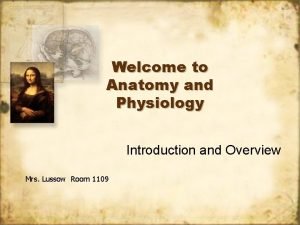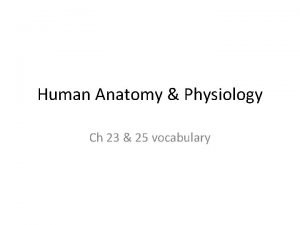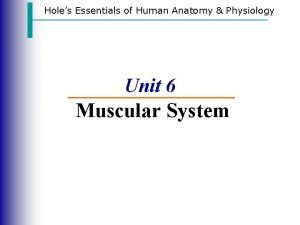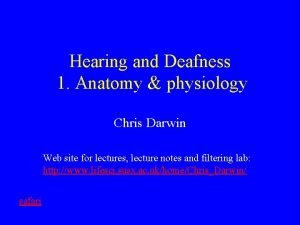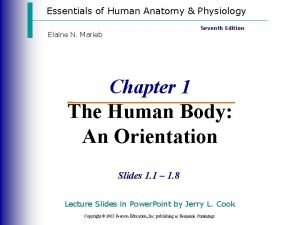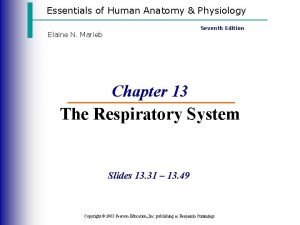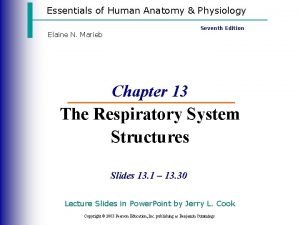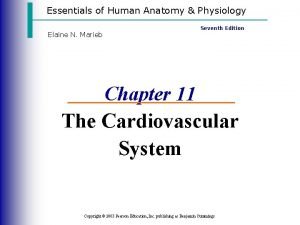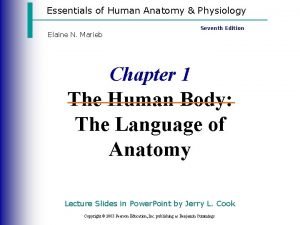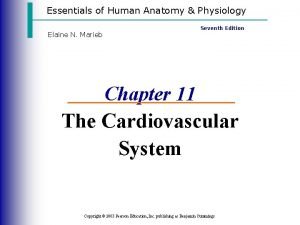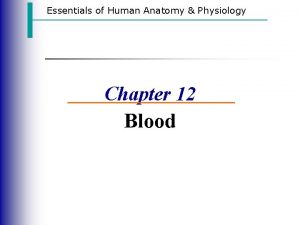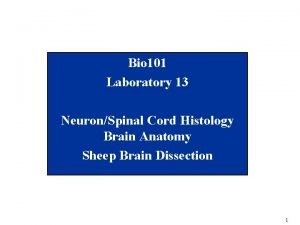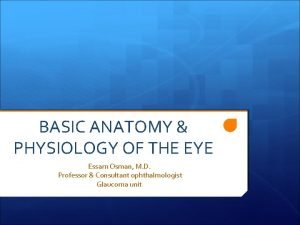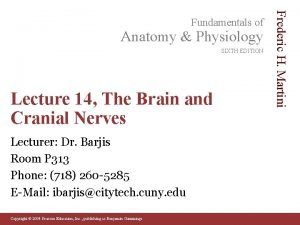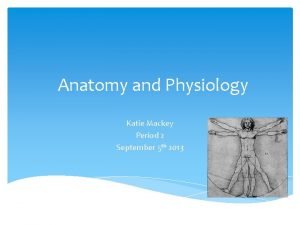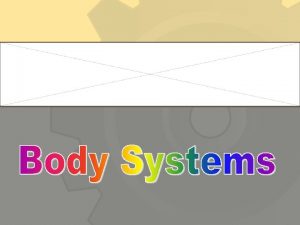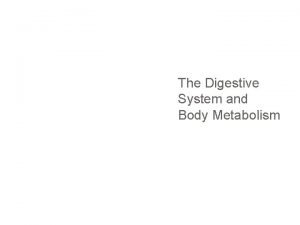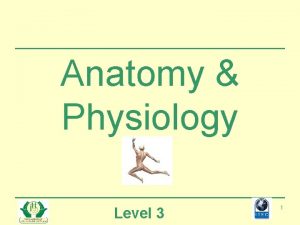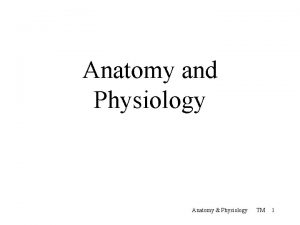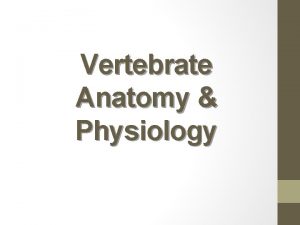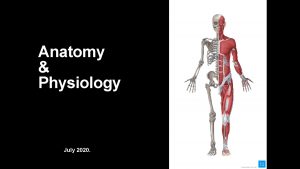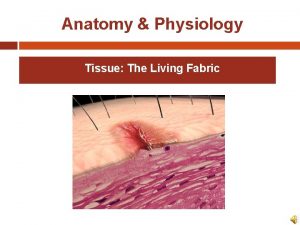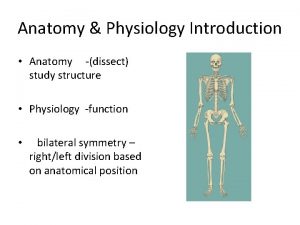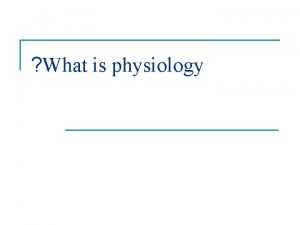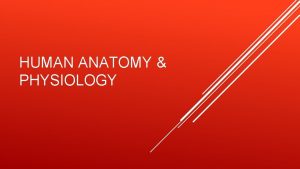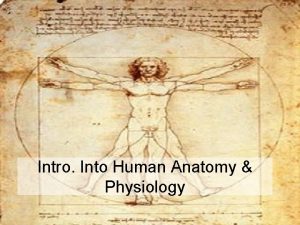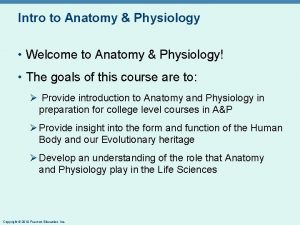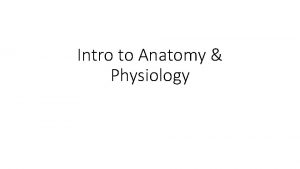Foundational Terms and Concepts Anatomy and Physiology of









































































- Slides: 73

Foundational Terms and Concepts Anatomy and Physiology of Human Movement 420: 050

Outline l l l Introduction Terminology Planes and Axes Movements Osteology Arthrology

Introduction l Road Map l l l Terminology Critical concepts l Planes and axes l Joint movements l Arthrology (osteology) l Muscle structure and function l Basic biomechanics Joint systems l Upper body – shoulder girdle, shoulder joint, elbow complex, wrist and hand joints l Lower body – pelvic girlde, hip joint, knee joint, ankle and foot joints l Trunk

Outline l l l Introduction Terminology Planes and Axes Movements Osteology Arthrology

Reference positions l Basis from which to describe joint movements l l l Anatomical position Fundamental position Standing in an upright posture, feet parallel and close, palms forward Fundamental position l Same with palms facing the body

Anatomical Directional Terminology l Anterior l l Posterior l l Nearest the trunk or the point of origin Lateral l l Situated away from the center or midline of the body Proximal l l Above in relation to another structure Distal l l Below in relation to another structure Superior (supra) l l In back in relation to another structure Inferior (infra) l l In front in relation to another structure On or to the side Medial l Relating to the middle or center From Van De Graaff KM: Human anatomy, ed 6, New York, 2002, Mc. Graw-Hill

Anatomical Directional Terminology l l l l Contralateral l Pertaining to the opposite side Ipsilateral l On the same side Bilateral l Relating to the right and left sides of the body Deep l Beneath or below the surface Superficial l Near the surface Prone l stomach lying Supine l lying on the back

Body Regions l Axial l l Cephalic (Head) Cervical (Neck) Trunk (Thoracic and Lumbar) Appendicular l l Upper limbs Lower limbs

Outline l l l Introduction Terminology Planes and Axes Osteology Arthrology Movements

Planes of Motion l l l Imaginary two-dimensional surface through which a limb or body segment is moved Motion through a plane revolves around an axis There is a ninety-degree relationship between a plane of motion & its axis

Cardinal Planes of Motion l l l Sagittal Plane Frontal Plane Transverse Plane Modified from Booher JM, Thibodeau GA: Athletic injury assessment, ed 4, New York, 2000, Mc. Graw-Hill

Cardinal Planes of Motion l Sagittal Plane l l l Divides body into equal, bilateral segments Bisects body into 2 equal symmetrical halves or a right & left half Movements? Modified from Booher JM, Thibodeau GA: Athletic injury assessment, ed 4, New York, 2000, Mc. Graw-Hill

Cardinal Planes of Motion l Frontal Plane l l Divides the body into (front) anterior & (back) posterior halves Movements? Modified from Booher JM, Thibodeau GA: Athletic injury assessment, ed 4, New York, 2000, Mc. Graw-Hill

Cardinal Planes of Motion l Transverse Plane l l Divides body into (top) superior & (bottom) inferior halves when the individual is in anatomic position Movements? Modified from Booher JM, Thibodeau GA: Athletic injury assessment, ed 4, New York, 2000, Mc. Graw-Hill

Diagonal Planes of Motion

Axes of Rotation l Two basic types of movement l l Linear Angular For angular movement to occur in a plane, it must turn or rotate about an axis as referred to previously The axes are named in relation to their orientation

Axes of Rotation l Mediolateral (ML) Axis l l l Has same orientation as frontal plane of motion & runs from side to side at a right angle to sagittal plane of motion Runs medial / lateral Also known as: l Frontal, Lateral or Coronal Axis Modified from Booher JM, Thibodeau GA: Athletic injury assessment, ed 4, New York, 2000, Mc. Graw-Hill

Axes of Rotation l Anteroposterior (AP) Axis l l l Has same orientation as sagittal plane of motion & runs from front to back at a right angle to frontal plane of motion Runs anterior / posterior Also known as: l Sagittal Axis Modified from Booher JM, Thibodeau GA: Athletic injury assessment, ed 4, New York, 2000, Mc. Graw-Hill

Axes of Rotation l Suprainferior (SI) Axis l l l Runs straight down through top of head & is at a right angle to transverse plane of motion Runs superior/ inferior Also known as: l Long or Vertical Axis Modified from Booher JM, Thibodeau GA: Athletic injury assessment, ed 4, New York, 2000, Mc. Graw-Hill

Axes of Rotation l Diagonal or Oblique Axis l l Also known as the oblique axis Right angle to the diagonal plane

Outline l l l Introduction Terminology Planes and Axes Movements Osteology Arthrology

Movements l General: l l l Flexion/Extension Abduction/Adduction Circumduction Internal/External Rotation Specific: l l Ankle Radioulnar Shoulder girdle Spine and pelvic girdle

GENERAL l Flexion l l Extension l l Straightening movement that results in an increase of angle Joints: l l Bending movement that results in a decrease of angle Spine, shoulder, elbow, wrist, fingers, hip, knee, ankle*, toes Plane and axis?

GENERAL l Abduction l l Adduction l l Movement medially toward midline Joints: l l Lateral movement away from midline of trunk Spine*, shoulder, wrist*, fingers, hip, ankle*, toes Plane and axis?

GENERAL l Horizontal Abduction: l l Horizontal Adduction: l l Movement towards the midline while parallel to the ground Joints: l l Movement away from the midline while parallel to the ground Shoulder and hip Plane and axis?

GENERAL l Circumduction l l l Joints: l l Circular movement of a limb that delineates an arc or describes a cone Combination of flexion, extension, abduction, & adduction Spine, shoulder, wrist, fingers, hip, ankle, toes Planes and axes?

GENERAL l Internal rotation l l External rotation l l Rotary movement around longitudinal axis of a bone away from midline of body Joints: l l Rotary movement around longitudinal axis of a bone toward midline of body Spine*, shoulder and hip Plane and axis?

SPECIFIC: ANKLE & FOOT l Inversion l l Turning sole of foot inward or medially Eversion l Turning sole of foot outward or laterally

SPECIFIC: ANKLE & FOOT l Plantar flexion: l l Extension movement of ankle that results in foot moving away from body Dorsal flexion (dorsiflexion): l Flexion movement of ankle that results in top of foot moving toward anterior tibia bone

SPECIFIC: RADIOULNAR JOINT l Pronation l l Internally rotating radius where it lies diagonally across ulna, resulting in palm-down position of forearm Supination l Externally rotating radius where it lies parallel to ulna, resulting in palm-up position of forearm

SPECIFIC: SHOULDER GIRDLE l Elevation l l Superior movement of shoulder girdle Depression l Inferior movement of shoulder girdle

SPECIFIC: SHOULDER GIRDLE l Protraction l l l Forward movement of shoulder girdle away from spine Abduction of the scapula Retraction l l Backward movement of shoulder girdle toward spine Adduction of the scapula

SPECIFIC: SHOULDER GIRDLE l Rotation upward l l Rotary movement of scapula with inferior angle of scapula moving laterally & upward Rotation downward l Rotary movement of scapula with inferior angle of scapula moving medially & downward

SPECIFIC: SPINE AND PELVIS l Lateral flexion (side bending) l l l Movement of head and / or trunk laterally away from midline Abduction of spine Reduction l l Return of spinal column to anatomic position from lateral flexion Adduction of spine

SPECIFIC: SPINE AND PELVIS l Anterior pelvic tilt l l Posterior pelvic tilt l l Iliac crest forward Iliac crest backward Plane and axis?

SPECIFIC: WRIST & HAND l Radial flexion (radial deviation) l l Abduction movement at wrist of thumb side of hand toward forearm Ulnar flexion (ulnar deviation) l Adduction movement at wrist of little finger side of hand toward forearm

SPECIFIC: WRIST & HAND l Opposition of the thumb l Diagonal movement of thumb across palmar surface of hand to make contact with the hand and/or fingers

Outline l l l Introduction Terminology Planes and Axes Movements Osteology Arthrology

Skeletal System Modified from Van De Graaff KM: Human anatomy, ed 6, New York, 2002, Mc. Graw-Hill

Osteology – Interesting Facts l 206 bones l l l Composed of calcium carbonate, calcium phosphate, collagen, & water l l l Axial skeleton: 80 bones Appendicular: 126 bones 60 -70% of bone weight - calcium carbonate & calcium phosphate 25 -30% of bone weight – water ~1/5 th of the skeleton replaces itself in one year in young adults

Skeletal Functions 1. 2. 3. 4. 5. Protection of inner organs, brain, spinal cord etc. Support to maintain posture Movement by serving as points of attachment for muscles and acting as levers Mineral storage such as calcium & phosphorus Hemopoiesis – in vertebral bodies, femur, humerus, ribs, & sternum l process of blood cell formation in the red bone marrow

Types of bones l l l Long bones - humerus, fibula Short bones - carpals, tarsals Flat bones - skull, scapula Irregular bones - pelvis, ear ossicles Sesamoid bones - patella

Types of Bones l Long bones l l Composed of a long cylindrical shaft with relatively wide, protruding ends Shaft contains the medullary canal Ex. Phalanges, metatarsals, metacarpals, tibia, fibula, femur, radius, ulna, & humerus Function: Levers

Types of Bones l Short bones l l l Small, cubical shaped, solid bones that usually have a proportionally large articular surface in order to articulate with more than one bone Ex. Carpals & tarsals Function: Shock absorption

Types of Bones l Flat bones l l l Usually have a curved surface & vary from thick where tendons attach to very thin Ex. ilium, ribs, sternum, clavicle, & scapula Function: Protection, large surface area for muscle/tendon attachment

Types of Bones l Irregular bones l l l Include bones throughout entire spine & ischium, pubis, & maxilla Function: Varies Sesamoid bones l l Patella, flexor tendon of thumb and big toe Function: Improvement of mechanical advantage

Typical Bony Features l l Diaphysis – long cylindrical shaft Cortex - hard, dense compact bone forming walls of diaphysis l Periosteum - dense, fibrous membrane covering outer surface of diaphysis l Endosteum - fibrous membrane that lines the inside of the cortex l Medullary (marrow) cavity – between walls of diaphysis, containing yellow or fatty marrow From Shier D, Butler J, Lewis R: Hole’s human anatomy & physiology, ed 9, New York, 2002, Mc. Graw-Hill.

Typical Bony Features l l l Epiphysis – ends of long bones formed from cancelleous (spongy or trabecular) bone Epiphyseal plate - (growth plate) thin cartilage plate separates diaphysis & epiphyses Articular (hyaline) cartilage – covering the epiphysis to provide cushioning effect & reduce friction Modified from Van De Graaff KM: Human anatomy, ed 6, New York, 2002, Mc. Graw-Hill.


Bone Growth l l l Grow rapidly into structures shaped similar to the bones which they will eventually become Growth continues and gradually undergoes significant change to develop into long bone Longitudinal growth continues as long as epiphyseal plates are open Shortly after adolescence, plates disappear & close Most close by age 18, but some may be present until 25 Growth in diameter continues throughout life

Bone Properties l l l Bone size & shape are influenced by the direction & magnitude of forces that are habitually applied to them Bones reshape themselves based upon the stresses placed upon them (remodeling) Bone mass increases over time with increased stress

Bone Markings l Processes (including elevations & projections) l Processes that form joints l Condyle: Large, smooth, rounded projection l Facet: Small flat surface l Head: Rounded projection of epiphysis separated by a neck


Bone Markings l Processes (elevations & projections) l Processes to which ligaments, muscles or tendons attach l l l l l Crest: Narrow and ridgelike process Epicondyle: Projection above condyle Line: Ridge of bone (less prominent than crest) Process: Any projection Spine (spinous process): Sharp, slender projection Suture: Line of union between bones Trochanter: Large roughened projection Tubercle: Small rounded projection Tuberosity: Small roughened projection



Bone Markings l Cavities (depressions) - including opening & grooves l l Foramen: Rounded hole or opening for blood vessels or nerves Fossa: Shallow depression or flattened surface Sulcus (groove): Narrow furrow or groove-like depression Notch: Depression in the margin of a bone


Outline l l l Introduction Terminology Planes and Axes Movements Osteology Arthrology

Classification of Joints l l Articulation - connection of bones at a joint usually to allow movement between surfaces of bones 3 major classifications according to structure & movement characteristics l Synarthrodial l Amphiarthrodial l Diarthrodial

Classification of Joints Structural classification Synarthrodial Amphiarthrodial Fibrous Cartilagenous Synovial Gomphosis Suture ----- Syndesmosis Symphysis Synchondrosis ----- Arthrodial Condyloidal Enarthrodial Ginglymus Sellar Trochoidal Functional classification Diarthrodial -----

Synarthrodial l l Immovable joints Suture: l l Bony matrix/cement between bones Gomphosis such as teeth fitting into mandible or maxilla l Conical peg and socket Modified from Booher JM, Thibedeau GA: Athletic injury assessment, ed 4, New York, 2000, Mc. Graw-Hill.

Classification of Joints Structural classification Synarthrodial Amphiarthrodial Fibrous Cartilagenous Synovial Gomphosis Suture ----- Syndesmosis Symphysis Synchondrosis ----- Arthrodial Condyloidal Enarthrodial Ginglymus Sellar Trochoidal Functional classification Diarthrodial -----

Amphiarthrodial l l Slightly movable joints Allow a slight amount of motion to occur l Syndesmosis l Synchondrosis l Symphysis

Amphiarthrodial l Syndesmosis l l l Two bones joined together by a strong ligament or an interosseus membrane that allows minimal movement between the bones Bones may or may not touch each other at the actual joint Ex. Coracoclavicular joint, distal tibiofibular jt. Modified from Booher JM, Thibedeau GA: Athletic injury assessment, ed 4, New York, 2000, Mc. Graw-Hill.

Amphiarthrodial l Synchondrosis l l Type of joint separated by hyaline cartilage that allows very slight movement between the bones Ex. costochondral joints of the ribs with the sternum Modified from Booher JM, Thibedeau GA: Athletic injury assessment, ed 4, New York, 2000, Mc. Graw-Hill.

Amphiarthrodial l Symphysis l l Joint separated by a fibrocartilage pad that allows very slight movement between the bones Ex. Symphysis Pubis & intervertebral discs Modified from Booher JM, Thibedeau GA: Athletic injury assessment, ed 4, New York, 2000, Mc. Graw-Hill.

Classification of Joints Structural classification Synarthrodial Amphiarthrodial Fibrous Cartilagenous Synovial Gomphosis Suture ----- Syndesmosis Symphysis Synchondrosis ----- Arthrodial Condyloidal Enarthrodial Ginglymus Sellar Trochoidal Functional classification Diarthrodial -----

Diarthrodial Joints l l l Known as synovial joints Freely movable Composed of sleevelike joint capsule Secretes synovial fluid to lubricate joint cavity Capsule thickenings form tough, nonelastic ligaments that provide additional support against abnormal movement or joint opening Ligaments may also be located inside the joint

Diarthrodial Joints l Articular or hyaline cartilage covers the articular surface ends of the bones inside the joint cavity l l l absorbs shock protect the bone Cartilage slowly absorbs synovial fluid during joint unloading or distraction Secretes synovial fluid during subsequent weight bearing & compression Some diarthrodial joints have specialized fibrocartilage disks (menisci)

From Seeley RR, Stephens TD, Tate P: Anatomy & physiology, ed 7, New York, 2006, Mc. Graw-Hill.

Diarthrodial Joints l l Diarthrodial joints have motion possible in one or more planes Degrees of freedom l l l motion in 1 plane = 1 degree of freedom motion in 2 planes = 2 degrees of freedom motion in 3 planes = 3 degrees of freedom

Diarthrodial Joints l l l Six types Each has a different type of bony arrangement between articulating surfaces Structure dictates function Structural classification Synarthrodial Amphiarthrodial Fibrous Cartilagenous Synovial Gomphosis Suture ----- Syndesmosis Symphysis Synchondrosis ----- Arthrodial Condyloidal Enarthrodial Ginglymus Sellar Trochoidal Functional classification Diarthrodial -----
 Upper respiratory labeled
Upper respiratory labeled Tattoo anatomy and physiology
Tattoo anatomy and physiology Anatomy science olympiad
Anatomy science olympiad Incomplete flower
Incomplete flower Anatomy and physiology of bone
Anatomy and physiology of bone Duodenal ulcer anatomy
Duodenal ulcer anatomy Liver anatomy and physiology
Liver anatomy and physiology Podbřišek
Podbřišek Hypogastric region
Hypogastric region Straw coloured fluid
Straw coloured fluid The central sulcus divides which two lobes? (figure 14-13)
The central sulcus divides which two lobes? (figure 14-13) 3 layers of muscle
3 layers of muscle Http://anatomy and physiology
Http://anatomy and physiology Waistline
Waistline Physiology of appendicitis
Physiology of appendicitis Aohs foundations of anatomy and physiology 1
Aohs foundations of anatomy and physiology 1 Aohs foundations of anatomy and physiology 1
Aohs foundations of anatomy and physiology 1 Anatomical planes
Anatomical planes Anatomy and physiology chapter 8 special senses
Anatomy and physiology chapter 8 special senses Chapter 13 anatomy and physiology of pregnancy
Chapter 13 anatomy and physiology of pregnancy Unit 26 self evaluation answers
Unit 26 self evaluation answers Science olympiad forensics cheat sheet
Science olympiad forensics cheat sheet Anatomy and physiology chapter 2
Anatomy and physiology chapter 2 Liver anatomy and physiology ppt
Liver anatomy and physiology ppt Pancreas anatomy and physiology
Pancreas anatomy and physiology Anatomy and physiology chapter 7
Anatomy and physiology chapter 7 Anatomy and physiology coloring workbook figure 14-1
Anatomy and physiology coloring workbook figure 14-1 Chapter 10 blood anatomy and physiology
Chapter 10 blood anatomy and physiology Aohs foundations of anatomy and physiology 1
Aohs foundations of anatomy and physiology 1 Aohs foundations of anatomy and physiology 1
Aohs foundations of anatomy and physiology 1 Anatomy and physiology
Anatomy and physiology Anatomy and physiology chapter 15
Anatomy and physiology chapter 15 Cornell notes for anatomy and physiology
Cornell notes for anatomy and physiology Anatomy and physiology ninth edition
Anatomy and physiology ninth edition Necessary life functions anatomy and physiology
Necessary life functions anatomy and physiology Holes anatomy and physiology chapter 1
Holes anatomy and physiology chapter 1 Holes essential of human anatomy and physiology
Holes essential of human anatomy and physiology Anatomy and physiology unit 7 cardiovascular system
Anatomy and physiology unit 7 cardiovascular system Gi tract histology
Gi tract histology Anatomy and physiology
Anatomy and physiology Medial and lateral
Medial and lateral Aohs foundations of anatomy and physiology 1
Aohs foundations of anatomy and physiology 1 Aohs foundations of anatomy and physiology 1
Aohs foundations of anatomy and physiology 1 Cephalic cranial
Cephalic cranial Animal physiology exam 1
Animal physiology exam 1 Welcome to anatomy and physiology
Welcome to anatomy and physiology Anatomy and physiology of the foot
Anatomy and physiology of the foot Anatomy and physiology of psoriasis
Anatomy and physiology of psoriasis Pancreas anatomy histology
Pancreas anatomy histology Anatomy and physiology vocabulary
Anatomy and physiology vocabulary Anatomy and physiology
Anatomy and physiology Muschiul subclavicular
Muschiul subclavicular Anatomy and physiology
Anatomy and physiology Body landmarks diagram
Body landmarks diagram Anatomy and physiology
Anatomy and physiology Anatomy and physiology
Anatomy and physiology Anatomy and physiology
Anatomy and physiology Dorsifelxion
Dorsifelxion Anatomy and physiology
Anatomy and physiology Anatomy and physiology
Anatomy and physiology Anatomy and physiology
Anatomy and physiology Figure 10-1 blood
Figure 10-1 blood Chapter 2 human reproductive anatomy and physiology
Chapter 2 human reproductive anatomy and physiology Human anatomy and physiology 10th edition
Human anatomy and physiology 10th edition Inferior view of sheep brain labeled
Inferior view of sheep brain labeled Anatomy and physiology of eye
Anatomy and physiology of eye Oblongata
Oblongata Irn.org anatomy and physiology
Irn.org anatomy and physiology Anatomy and physiology body parts
Anatomy and physiology body parts Unit 26 animal anatomy physiology and nutrition
Unit 26 animal anatomy physiology and nutrition The digestive system and body metabolism
The digestive system and body metabolism Anatomy and physiology of the retina
Anatomy and physiology of the retina Mucous connective tissue
Mucous connective tissue Anatomy and physiology of meningitis ppt
Anatomy and physiology of meningitis ppt













































